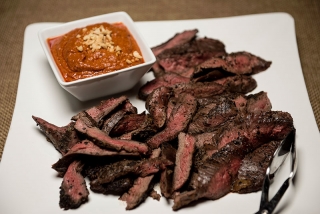
Peanuts: Popular legume served from US ballparks to restaurants in Asia
05 November 2019Peanuts are more than a ballpark snack or jelly accompaniment because of their culinary versatility and popularity in global cuisines. Here are some local and international applications for this loveable legume and reasons why chefs go nuts for peanuts.
First off, it should be noted that peanuts are botanically a legume. Unlike tree nuts (many of which are also not botanically nuts), peanuts actually grow underground. But because they are legumes, they have some inherent sustainable traits that other nuts lack. (Click here to read a Gold Medal Classroom’s Meet the Grower story featuring Gayle White , Oklahoma peanut farmer.)
Peanuts can fix their own nitrogen, which reduces their need for fertilizer and helps replenish nitrogen in the soil. That’s why they are a common rotation crop with cotton and corn. Peanuts also use significantly less water than other nuts. It only takes about five gallons of water to produce a one-ounce serving of peanuts, versus 80 gallons of water to produce a one-ounce serving of almonds.
While peanuts are classified as a legume, they are considered nuts in the culinary sense because of their nutritional profile and how people consume them. Like other nuts, peanuts are made up of mostly protein and fat. They have seven grams of protein per serving (more than any other nut), fiber, and mostly heart-healthy unsaturated fat.
Peanuts work equally as well in both sweet and savory applications. Salted, roasted or boiled peanuts are a satisfying snack that pairs perfectly with a beer. Over the years, peanut butter has become a surprisingly popular addition to burgers. It’s an odd pairing, but it works because the roasted nuttiness of the peanut butter compliments the beef. Some chefs have taken the pairing a step further. Bacchanalia restaurant in Atlanta recently served up peanuts and beef tartar. As for use in sweets, who doesn’t love peanuts and chocolate? But peanuts are also a common ingredient in popular global cuisines.
Peanuts are ubiquitous throughout Asia, and many cultures incorporate peanuts into common dishes. Satay sauces blend peanuts with sweet and spicy flavors. That sauce can go beyond its traditional use to be served on vegetables and even sweet potatoes. Peanuts also add a signature crunch to Laotian larb gai and Chinese kung pao. Ground peanuts or peanut butter adds a nutty savoriness to both vegetarian and meat-based African stews, and peanut milk punch is a popular creamy drink in the Caribbean.
When harvested, peanuts generally have a very high water content and are considered “green” peanuts. Green peanuts more closely resemble beans, and chefs and foodservice operators across the South use them for boiling. When treated like a bean, boiled peanuts are a delicious addition to other beans and field peas. They can even be pureed to make a Southern take on hummus. Because green peanuts have a higher water content, they also have a shorter shelf life. As such, they are typically only available in market produce coolers across the South during harvest time—late summer through fall.
Most peanuts are dried in the field or in commercial driers to reduce their moisture content to about 10 percent and these are considered “raw” peanuts. Raw peanuts can also be boiled, but most are used for roasting which helps bring out the nutty taste and crunchy texture that we are most familiar with.
When it comes to serving peanuts, it’s important to remember that they are one of the eight most common food allergens in the U.S. That said, it’s also worth keeping in mind that peanut allergies affect less than two percent of the population. Handling peanuts in the kitchen should be no different than handling tree nuts, seafood, eggs or even milk. It’s necessary to prevent cross-contact of these ingredients with the food of an allergic customer. The only exception is refined peanut oil is not considered allergenic by the FDA because the peanut protein is removed during the refining process.
Nevertheless, peanuts remain one of the most popular nuts among consumers. In fact, according to a survey conducted by the National Peanut Board, millennials said that peanuts are their favorite nut and one-third of the millennial respondents said they were more likely to buy a menu item that contained peanuts or peanut butter. With a taste and texture that can go with a variety of dishes, and as a common ingredient in trendy global cuisines, it’s no wonder that peanuts are more popular than ever.
Visit the National Peanut Board for more information and peanuts recipes.
Photos courtesy of the National Peanut Board
